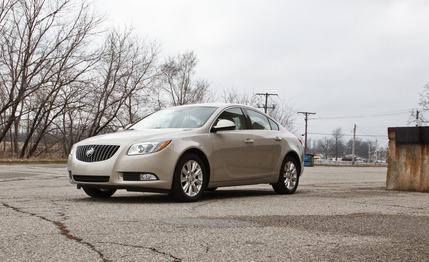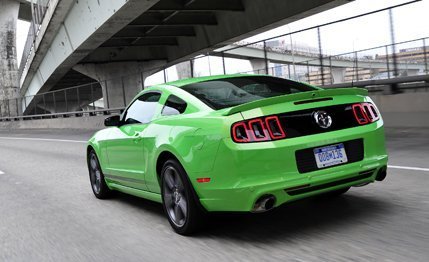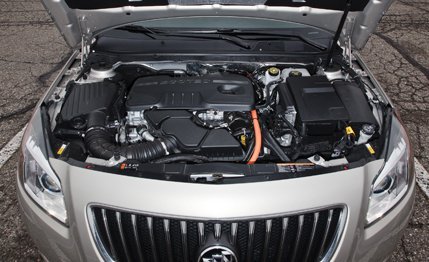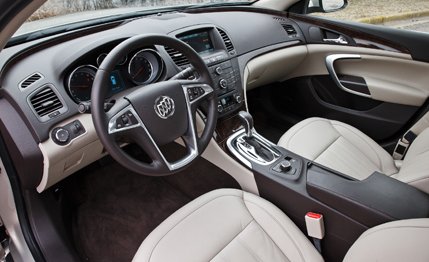
 Instrumented Test
Instrumented Test


Since 1973, the Buick Regal has taken the form of landau-roofed barge, square-jawed personal coupe, bad-ass muscle car, shark-nosed jellybean, forgettable sedan (more than once), and, as it sits in Buick showrooms today, Opel-derived near-luxury four-door. For 2012, the 270-hp Regal GS adds “competent sports sedan” to that list, and Buick wouldn’t mind if the Regal eAssist were described as a “high-tech fuel sipper.” But we won’t be the ones to do so. At least not based on this first real-world test.
The Regal eAssist features active grille shutters, underbody aerodynamics, and the light electrification of the base Regal’s 2.4-liter direct-injected four-cylinder. The latest version of GM’s mild-hybrid system is comprised of a 20-hp electric motor/generator (providing a maximum 15 hp of assistance) that takes the place of a conventional alternator, a 0.5-kWh lithium-ion battery tucked behind the right rear seatback, and a lower final-drive ratio. (The same setup is found in the 2013 Chevrolet Malibu Eco and is the new base powertrain for Buick’s larger LaCrosse sedan.) It intends to make the Regal a little bit quicker and some 25 percent more fuel efficient, which translates to EPA fuel-economy figures of 25 mpg in the city and 36 mpg on the highway. After running through our normal battery of tests at the track, we took to the streets to see if that efficiency claim would hold up.
Quicker? Yes. More Efficient? Sure
At 8.1 seconds to 60 mph, the eAssist is 0.6 second quicker off the line than the last non-turbo Regal we tested. Its 30-to-50-mph passing time of 4.4 seconds and 50-to-70-mph time of 6.4 seconds are 0.2 and 0.4 second better, as well. We noted that light pedal application usually isn’t enough to rouse the electric motor, but once tapped, it effectively brings the naturally aspirated Regal from slow to, well, less slow.


Meanwhile, the low-rolling-resistance tires—they’re mounted to 17-inch wheels, downsized from 18s on the nonhybrid Regal—are the likely culprits for the eAssist model’s loss of 0.03 g of lateral grip (at 0.82 g) and the unwelcome addition of seven feet to the 70-to-0-mph braking distance (181 feet). Even so, the eAssist car retains the standard Regal’s dynamic character. It’s reasonably sharp and connected (especially by past Buick standards) and provides an overall pleasurable driving experience—as long as you’re not in a big rush. The steering still has a bit of a dead spot on-center, but that’s no fault of the hybridization.
The point of all that technology—indeed, the very crux of this new model’s existence—is to significantly boost fuel economy without adding the cost and weight that come with full-hybrid systems. We did see a modest economy bump materialize. Our average over about 1000 miles driven landed at 26 mpg, which is 4 mpg better than the number we got from an eAssist-less 2.4-liter Regal. Consider that a turbocharged Regal 2.0T managed 27 mpg in a comparison test, however, and suddenly the eAssist car doesn’t sound so fuel sippy.
Doesn’t Drive like a Hybrid
What the numbers don’t convey is the Regal eAssist’s distinct lack of hybrid weirdness. There’s no full-EV mode, no electric ringing-in-the-ears soundtrack, no super-artificial deceleration from the regenerative brakes. Instead, the eAssist drives, looks, and, for all intents and purposes, is just like a standard Regal.


And it’s not much more expensive. For 2012, the eAssist option adds $2000 to the base price of a Regal, for a total of $29,350. There will be no choice in 2013, when the base 2.4-liter model is killed off and all naturally aspirated Regals get eAssist. Our high-content, $32,375 Premium II test car offers the luxuries a normal customer would want, including a Harman/Kardon sound system, extremely comfortable leather chairs, HID headlamps, remote start, keyless access, Bluetooth, a $1000 sunroof option, and a $1145 navigation system upgrade that includes an iDrive-like redundant control dial. The more we drove the car, the more we liked it, which is something we’re not always able to say about some of the Regal’s full-hybrid competitors.
With the addition of eAssist, Buick has chosen a middle-of-the-road hybrid approach that in our hands returned middle-of-the-road results, especially compared with the more expensive Regal turbo’s gas mileage. For that reason, we’re not going to call this a high-tech fuel sipper. Let’s just go with medium-tech, somewhat-fuel-averse sedan.